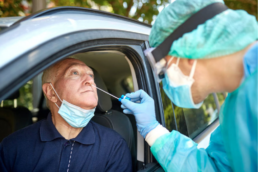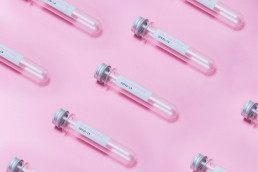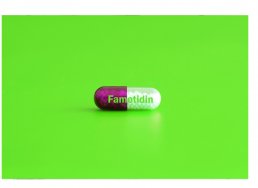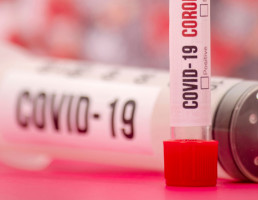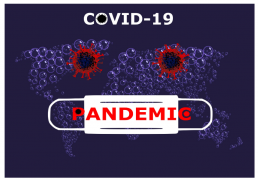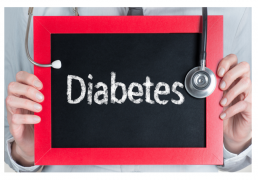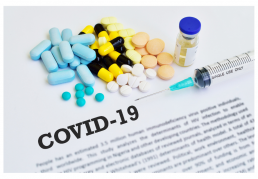Now Offering RT-PCR Testing with Results in 1 hour!
We NOW OFFER RT-PCR Testing with Results in 1 hour!
How does it work?
All testing is performed outside of the pharmacy, with parking in front of the pharmacy in any of the 15 minute parking spots. When you arrive at the pharmacy, please call our main line at 619-303-7771 and someone will be right out to assist.
Once you arrive our staff member will provide you with the testing kit. You will be instructed on the steps needed to complete the test. The test is an anterior nasal swab (it is inserted only at the tip of the nose). The test is completely self-contained – no mixing of fluids or complex testing procedure required. Once the swab is performed our staff will send your results via e-mail OR you may pick up your results once they are ready. Results may be ready in as little as 1 hour.
What is the age requirement for testing?
The minimum age for testing is 2 and above.
What is the Turn Around Time (When should I expect my results)?
The estimated turnaround time is 1 hour. Results will be sent via e-mail (or may choose to pick up) with same day results. If your results are NOT needed in 1 hour we offer additional turn around times. Please refer to "What is the cost of the PCR" for additional information on turn around times.
Is the Lab CLIA-certified?
Yes, our pharmacy has a CLIA waiver.
Is the test FDA approved?
The kit has an emergency authorization use by the FDA.
What is the cost of the PCR?
The cost varies on how soon you need your results.
Results within 48 hours is $175.
Results within 24 hours is $199.
Results within 1 hour is $329.
Do you accept health insurance?
At this time, we do not directly bill health insurance. We will be glad to provide you with a detailed receipt that you may wish to turn into your insurance to seek possible reimbursement.
Will it meet my travel requirements?
Due to ongoing changes and differences between airlines/countries/states requirement, we cannot assure that your results will be accepted for specific travel requirements. We recommend that you reach out to your airline/country for exact requirements and if the test RT-PCR test offered by Rancho Pharmacy will meet those requirements.
Does your test meet the requirements for Hawaii?
No our test will NOT be sufficient for travel to Hawaii.
I received a negative test what does this mean?
The Cue COVID-19 Test is a U.S. FDA Emergency Use Authorized molecular nucleic acid amplification test (NAAT) that detects the genetic material of SARS-CoV-2 using a molecular amplification reaction that is an equivalent amplification method to molecular polymerase chain reaction (PCR). A Negative result means that Cue COVID-19 Test did not detect SARS-CoV-2 virus in your sample.
How do I register?
You may register online on our website under COVID testing. Make sure to select PCR when choosing what type of the test. We also recommend you remind our staff member the type of test you wish to have performed.
What does it mean if the specimen tests negative for the virus that causes COVID-19?
A negative test result for this test means that SARS- CoV-2 RNA was not present in the specimen above the limit of detection. However, a negative result does not rule out COVID-19 and should not be used as the sole basis for treatment or patient management decisions. It is possible to test a person too early or too late during COVID-19 infection to make an accurate diagnosis via Cue COVID-19 Test.
In addition, asymptomatic people infected with COVID- 19 may not shed enough virus to reach the limit of detection of the test, giving a false negative result. In the absence of symptoms, it is difficult to determine if asymptomatic people have been tested too late or too early. Therefore, negative results in asymptomatic individuals may include individuals who were tested too early and may become positive later, individuals who were tested too late and may have serological evidence of infection, or individuals who were never infected.
When diagnostic testing is negative, the possibility of a false negative result should be considered in the context of a patient’s recent exposures and the presence of clinical signs and symptoms consistent with COVID-19. The possibility of a false negative result should especially be considered if the patient’s recent exposures or clinical presentation indicate that COVID- 19 is likely, and diagnostic tests for other causes of illness (e.g., other respiratory illness) are negative. If COVID-19 is still suspected based on exposure history together with other clinical findings, re-testing with an alternative method should be considered by healthcare providers in consultation with public health authorities. Additional testing may be helpful to ensure testing was not conducted too early.
Risks to a patient of a false negative test result include: delayed or lack of supportive treatment, lack of monitoring of infected individuals and their household or other close contacts for symptoms resulting in increased risk of spread of COVID-19 within the community, or other unintended adverse events.
The performance of this test was established based on the evaluation of a limited number of clinical specimens. The clinical performance has not been established in all circulating variants but is anticipated to be reflective of the prevalent variants in circulation at the time and location of the clinical evaluation. Performance at the time of testing may vary depending on the variants circulating, including newly emerging strains of SARS- CoV-2 and their prevalence, which change over time.
What does it mean if the specimen tests positive for the virus that causes COVID-19?
A positive test result for COVID-19 indicates that RNA from SARS-CoV-2 was detected, and therefore the patient is infected with the virus and presumed to be contagious.
Test results should always be considered in the context of clinical observations and epidemiological data in making a final diagnosis and patient management decisions. Patient management should be made by a healthcare provider and follow current CDC guidelines.
The Cue COVID-19 Test has been designed to minimize the likelihood of false positive test results. However, in the event of a false positive result, risks to patients could include the following: a recommendation for isolation of the patient, monitoring of household or other close contacts for symptoms, patient isolation that might limit contact with family or friends and may increase contact with other individuals with COVID-19, limits in the ability to work, the delayed diagnosis and treatment for the true infection causing the symptoms, unnecessary prescription of a treatment or therapy, or other unintended adverse effects.
#PCR#RT-PCR#NAAT#testign#covid-19
15 Minute COVID Testing Now Available
We are currently offering both Antigen and PCR testing!
What is the difference between Antigen and Antibody Testing? And when should I test?
An antigen test may be recommended for patients that have active symptoms of COVID or may have been recently exposed to COVID. While an antibody test may be recommended for a person who was previously exposed or had COVID wants to know if the body has developed an antibody for COVID-19.
An antigen test is designed to detect antigen early on and as the duration of illness increases an antigen sample may decrease. Specimens collected after day 5 of illness may be more likely to be negative compared to a RT-PCR assay.
An antibody test is suggested to detect as early as 2 weeks after symptoms start, peaks at 3 to 4 weeks and wanes over time.
What are the possible benefits of Antigen Test?
The possible benefits of a COVID-19 antigen test are that the results are quick and may help your doctor make informed recommendations about your care. In addition the results may help to limit the spread of COVID-19 to your family, friends and community.
What is the name of the Antigen Test that is being offered?
The antigen test that we are offering is the CareStart Rapid Antigen Test. This test is a lateral flow immunochromatographic assay that provides a qualitative detection of COVID-19 protein antigens.
What are the possible benefits of Antibody Test?
The possible benefits of a COVID-19 Antibody test are results are quick and may help a patient reveal if the body has made antibodies to COVID-19. The test gives a qualitative or “yes/no” result in about 15 minutes. Antibodies may provide additional protection against COVID-19. In addition you may qualify to donate Convalescent donor plasma which may help patients with active COVID-19 infections.
What is the name of the Antibody Test that is being offered?
The antibody test being offered is called the FaStep Rapid test. This test is a lateral flow immunochromatographic assay that provides a qualitative detection of COVID-19 Antibodies (IgM and IgG). The test is labeled as 100% sensitive and 98.8% specificity and published data suggests that this test has 100% sensitivity and 80% specificity.
Are the Antigen or Antibody Test FDA approved?
These tests have an Emergency Authorization Use (EUA) from the FDA. FDA may issue EUA when certain criteria are met, which includes that there are no adequate, approved, available alternatives, and based on the totality of scientific evidence available. An EUA has not undergone the same type of review as an FDA-approved Test and is not FDA-approved or cleared.
What to expect when arriving for COVID testing?
We ask that you call ahead to schedule an appointment (same day appointments are available).
If you are taking the antigen test, when you arrive, please park in the curbside pick up spot and call us at 619-303-7771. The pharmacist will come to your car and administer the test.
The antibody will be administered in the pharmacy with safety pre-cautions.
For the antigen test the pharmacist will insert a cotton swab into one nostril. The swab is then slowly rotated in a circle three to 5 times.
For the antibody test the pharmacist will draw a small amount of blood by performing a finger stick prick.
Results will be read in about 10 to 15 minutes.
What happens if I test positive for COVID-19 testing?
If you test positive for antibody test, you should continue to follow CDC guidelines including physical distancing, handwashing and mask-wearing. A positive test does NOT mean the patient’s immune or protected from reinfection.
What does it mean if I test negative for COVID-19 Antigen or Antibody testing?
A negative test does not mean the patient does not have COVID-19 or antibody. It is best to discuss with your provider.
If an antigen test was performed you may want to follow up with a PCR test (results are usually given within 1-2 days to up to 1 week) to confirm, if COVID-19 is still suspected based on exposure history together with other clinical findings.
If you received a negative test with an antibody test you may have tested too early or time may lapsed where your body may no longer have antibodies.
What may cause a false negative result?
False negative results may occur in patients currently taking or have a history of taking high doses of biotin (more than 10 mg per day).
Vitamin D
Vitamin D AND the Immune System
COVID-19 is increasingly on people’s minds and many are focusing on how to keep their immune systems strong. There is a link between vitamin D and strong immune systems. Vitamin D can regulate the innate and adaptive immune responses. When vitamin D is deficient there is a link to autoimmune disease and an increased susceptibility to infection. Cod liver oil, which has a high content of vitamin D, is often used in tuberculosis treatment. A report that included almost 19,000 patients from the years of 1988 to 1994, showed patients reporting low levels of vitamin D (<30 ng/ml) also self-reported recent upper respiratory infections. Although recent studies have not shown consistent results, most likely due to methodological concerns, there is one well-designed study in school aged children that demonstrated that vitamin D administration decreased the flu (influenza) by 42%.
What is vitamin D and what role does it play?
Vitamin D is a fat soluble vitamin that helps support healthy bones through calcium absorption, promoting bone mineralization, and providing immune and cardiovascular support. It also plays a role in muscle function and the brain function and emotional health.
Which vitamin D supplement is best? How much vitamin D?
There are two major types of vitamin D, vitamin D3 and vitamin D2. Humans produce vitamin D3, also known as cholecalciferol, in their skin when exposed to sunlight. The only other source of vitamin D3 is found in animals. Vitamin D2 is sourced from plant foods and is known as ergocalciferol.
Calcidol, also known as 25-hydroxyvitamin D3, is a pre-hormone made directly from cholecalciferol (vitamin D3). This occurs in the liver by the enzyme 25-hydroxylase CYP27A1. This pre-hormone is not active; however, it is the major form of vitamin D that circulates in the bloodstream. Vitamin D blood tests typically measure the concentration of this pre-hormone. The activated form is known as calcitriol (1,25-dihydroxyvitamin D3). The enzyme 1-alpha-hydroxlation CYP27B1, converts the pre-hormone (calcidiol) in the kidneys to the active form, calcitriol. This is the most potent steroid hormone in the body. (Yes Vitamin D is a hormone, and technically calling it a vitamin is a misnomer).
Most studies show that vitamin D3 (cholecalciferol) is more effective than vitamin D2 (ergocalciferol) at raising blood levels of calcifedol. The recommended daily dose is 2,000 IU of vitamin D3 per day. Always check with your provider before supplementing.
What about when we age, what happens to our vitamin D?
Studies have found as people age; they lose the amount of vitamin D they are able to produce from the sun. This may be a result of the loss of enzymes needed to synthesize the vitamin. Research has found that low levels of vitamin D may be linked to poor cognitive performances in seniors. In addition, if a person receives an adequate amount of vitamin D it may significantly lower levels of inflammation and physiologic stress, factors that may slow down aging.
What do my lab levels mean and what is normal?
Typically blood tests measure the levels of the inactive pre-hormone, Calcidol (25-hydroxyvitamin D3). Although this hormone is not active it is the most reliable measurement of an individual’s vitamin D level. Lab level numbers will vary from lab to lab and providers may differ in what they believe is normal or low. However, most experts recommend having a level between 20 ng/ml to 40 ng/ml, and many will also push for levels between 30 ng/ml to 40 ng/ml. In general levels below 10 ng/ml are considered deficient. If you have your lab levels drawn for vitamin D you will want to work closely with your provider to determine if your levels are low.
References:
- https://www.ncbi.nlm.nih.gov/pmc/articles/PMC3166406/. Accessed on March 20, 2020
- Urashima M, et al. Randomized trial of vitamin D supplementation to prevent seasonal influenza A in schoolchildren. Am J Clin Nutr. 2010; 91(5):1255–60. [PubMed: 20219962] Accessed on March 20, 2020
Is it COVID or Is it My Allergies?
Is it COVID or is it my allergies?
Spring is the season of pollen and that means allergies. But what if you are experiencing symptoms how do you know it is not COVID and it's just your alleriges?
Symptoms of COVID vs Allergies
Well per the CDC symptoms of COVID include a cough, fever, and sore throat. With allergies you will not experience a fever. This is a big clue that if you have a fever, it's probably something other than your allergies.
WIth allergies you may experience itchiness in your throat, but it should not feel sore. Also, with allergies you may experience itchy eyes, nose and ears.
With COVID you might feel extreme exhaustion, this not common with allergies. In addition, if it is your allergies you might have a runny nose and congestion and possibly a cough. However if you are feeling short of breath, where you are having trouble breathing this is probably not due to your allergies and is something else that needs medical attention.
If you are having trouble breathing or experiencing bluish lips or face, confusion or persistent pain or pressure in the chest you should seek medical attention immediately.
This post is not designed to substitute medical advice from your provider. If you have concerns, please always contact your healthcare provider.
References
- https://www.cdc.gov/coronavirus/2019-ncov/symptoms-testing/symptoms.html accessed on 11/27/2020
COVID and Children
MIS-C stands for multi-system inflammatory syndrome. Per the CDC it is a rare but severe condition that is reported around 2 to 4 weeks after the onset of COVID-19 in children and adolescents.
The condition is serious as the features include shock (with cardiac involvement), GI symptoms and significantly elevated markers of inflammation. Inflammation may include the heart, lungs, kidneys, brain, skin, eyes and GI organs. Symptoms may also include a prolonged fever, rash, and evidence of COVID. Per the CDC the cause of MIS-C is unknown, however many children that had MIS-C tested positive for COVID-19.
Parents and clinicians should keep an eye on all children diagnosed or having symptoms of COVID, as MIS-C may not appear until weeks after being infected.
In April 2020 a cluster of children in Europe were reported to have hyperinflammatory shock with features similar to Kawasaki disease and toxic shock syndrome. As of July 29, 2020, there were a total of 570 MIS-C cases reported to the state health departments. Out of the 570 patients 10 patients were reported to have died.
In addition, based on an analysis published by the CDC, the cumulative rate of COVID-19 associated hospitalizations among children (8 per 100,0000) has been low compared to adults (164.5). However, one in three hospitalized children were admitted to an intensive care unit.
This new emerging data means children are not immune to COVID-19. Caution should be taken not only with adults and children with underlying conditions, but everyone of all ages, regardless of underlying conditions. Call your provider if you come in contact with anyone with COVID or develop any symptoms.
References:
- https://www.cdc.gov/coronavirus/2019-ncov/daily-life-coping/children/mis-c.html. Accessed on August 11, 2020
- https://www.cdc.gov/mmwr/volumes/69/wr/mm6932e2.htm. Accessed on August 11, 2020
- https://www.cdc.gov/mmwr/volumes/69/wr/mm6932e3.htm?s Accessed on August 11, 2020
Famotidine and COVID
Based on preliminary data, famotidine a common heart burn medication that is available both by prescription and over the counter, may play a role in fighting COVID-19. This is based only on a small observation on data from patients in China who had heartburn and contracted COVID-19. From the study it was observed that 22% of the 1,536 patients who were not on famotidine died or were intubated and put on a ventilator. This was compared to the 84 patients that were on famotidine and 10% died or were put on a ventilator.
What is the mechanism behind famotidine?
The answer is unclear and needs to be researched further to validate if famotidine is beneficial in COVID-19. Zantac (or ranitidine) which belongs to the same class of medication was not shown to be effective against COVID-19. In addition, computer modeling has shown that the mechanism that famotidine uses to fight heartburn may also help against COVID-19. It does not appear to bind to an enzyme as some had speculated but rather it plays a role with histamine and COVID-19. Additional studies need to be performed before an answer is concluded.
There is a study in New York that is being conducted using high doses of famotidine in IV. The researchers will be posting the results as soon the trial ends. So, should you be using famotidine? There is not enough evidence to indicate to start taking famotidine. If you have heartburn and are concerned about COVID-19 work with your provider and pharmacist.
Reference:
- https://www.cnn.com/2020/05/09/health/famotidine-covid-19-correlation-study/index.html. Accessed on June 14, 2020
- https://blogs.sciencemag.org/pipeline/archives/2020/05/29/famotidine-histamine-and-the-coronavirus. Accessed on June 14, 2020
- https://www.drugtopics.com/latest/famotidine-trial-underway-nyc-covid-19-treatment. Accessed on June 14, 2020
- https://www.cuimc.columbia.edu/news/heartburn-drug-may-have-potential-against-covid-19. Accessed on June 14, 2020
COVID Testing
We have all heard that the key to preventing the virus from spreading is testing. But what types of tests are available and which one is the best?
As far as COVID testing there is not one test that is the BEST. It all depends on the person’s situation. The best way to determine which test is best for you is to work with your provider or pharmacist. Here is some information about the three different categories of tests that are available: PCR (a nasal or throat swab), Antigen (a nasal or throat swab) and an Antibody (a blood test).
PCR and Antigen are considered diagnostic tests as they can detect the virus earlier, while an antibody test detects antibodies later on. None are available to purchased directly by the consumer at this time.
PCR test is best to be used before or during symptoms. The virus is easily detectable within 7 to 10 days of illness. The test uses a process to test molecular breakdown of the virus. The Abbott ID Now test which delivers results within as little as 5 minutes is a PCR test.
An Antigen test is not reliable until symptoms exist. The peak or optimum testing time is about 3 to 5 days. The test is testing the coating of the virus.
The Antibody testing does not focus on checking the virus itself, but whether your immune system has built antibodies in response to the infection. It involves a small finger prick blood sample that takes at least 10 days to detect IgM antibody. Around 2 to 3 weeks later it can also detect IgG. These tests should be performed only on people that never had symptoms or it has been at least 7 days since their last symptom. If tested earlier, clinical reliability may be compromised.
More about Antibody testing…
There have been reports about fraudulent tests that are being sold. Here are a few things to watch for. As of now, there are no antibody tests on the market that have FDA approval, this will change with time. Testing kits are registering with the FDA and some have been granted an EUA (emergency authorization) by the FDA, but they are still not FDA approved. If you choose to receive an antibody test you will want to ask the person offering testing if they have checked and validated that the test has been registered with the FDA. In addition, tests that are on the market should have used PCR and not ELISA to validate their negative and positive results, as PCR is considered “Gold Standard” for COVID.
As far as the antibody test it tests for the antibodies IgM and IgG. IgM is the first antibody response to be detected. If IgG is detected and the level has become higher than IgM this means the maximum immunity response has occurred.
Keep in mind that these are qualitative tests not quantitative tests. This means it does not tell you how many antibodies, so it does not tell you if you are immune or how long you are immune. To measure immunity, you need to measure a titer, similar to a titer test performed after receiving your hepatitis B vaccines.
Therefore, Antibody testing does not tell you if you are immune but it does help in making decisions as far as when a person can stop being in quarantine and return to the workforce. It also helps with identifying donors for COVID-19 convalescent plasma.
In addition, look for the following to be labeled on a test:
1. This test has not been reviewed by the FDA
2. Negative results do not rule out SARS-CoV2 infection, particularly in those who have been in contact with the virus. Follow up testing with a molecular diagnostic should be considered to rule out infection in these individuals
3. Results from antibody testing should not be used as the sole basis to diagnose or exclude SARS-CoV2 infection or to inform infection status
4. Positive results may be due to past or present infection with non-SARS-CoV2 strains, such as coronavirus HKU1, NL63, OC43, 229E
What to Know About COVID-19
What is COVID-19?
COVID-19 is a disease that is transmitted by respiratory secretions. It is a novel, or new, strand of the coronavirus. COVID-19 is from the same family of MERS and SARS and thought to have originated as an animal coronavirus that infected people and then spread from people to people.
SARS-COV-2, which is a betacoronavirus, is the virus that causes COVID-19. COVID-19 is abbreviated for coronavirus disease 2019.
The disease classification has changed from an outbreak to epidemic to now a pandemic. The differences are how fast and quickly it can spread across a region. It is a world pandemic and as of today has spread to every continent except Antarctica. Because there is little to no immunity the virus is able to spread worldwide.
How is it transmitted?
COVID-19 is a respiratory infection that can be transmitted from respiratory droplets of infected people who cough or sneeze. Therefore, the CDC recommends people to stay at least 6 feet away from each other and not in direct contact. Some people may spread the virus prior to feeling symptoms. Additional ways of contracting the virus is from touching the surface or object that may have the virus and then touching your own mouth, nose or eyes.
Who is most at risk?
Since this virus is new, everyone is considered at risk. There are certain populations that are considered higher risk than others. This includes the elderly, infants, immunocompromised patients and anyone with an underlying condition, such as asthma or diabetes. This is a large population and it is important to be aware of the symptoms.
What are symptoms of COVID-19?
It may take days until symptoms do occur, anywhere from 2 to 14 days after exposure. Symptoms include a fever, dry cough, and itchy throat. Severe cases include difficulty breathing, requiring a respirator to help them breath. Call your doctor immediately if you think you have been exposed to COVID-19 and develop symptoms. The CDC states that emergency symptoms include: difficulty breathing or shortness of breath, persistent pain or pressure in the chest, new confusion or inability to arouse and bluish lips or face. Immediately seek medical help by calling your doctor if you think you have been exposed and are experiencing symptoms.
Diabetes AND COVID
Why are patients with diabetes considered more vulnerable to COVID-19?
The World Health Organization has categorized people with underlying conditions such as asthma, immunocompromised, and diabetes at greater risk for COVID-19.
Patients with asthma have a harder time of breathing when compared to someone who does not have asthma. Since COVID-19 is a virus transmitted thru respiratory secretions this puts patients with asthma in a high risk category. Immunocompromised patients have little to no immune system placing these patients at greater risk of infection including the COVID-19 virus. These reasons put these populations at larger risk for COVID-19.
But why are diabetes patients considered high risk for COVID-19?
There are two types of diabetes, Type I Diabetes and Type II Diabetes. Both involve a deficiency or absence of the body making insulin. In Type I Diabetes the body is making little to no insulin and patients must inject with the prescription insulin. In Type II Diabetes the body is not making enough insulin and are either adapting lifestyle changes, taking medications by mouth or injection and/or injecting insulin. When the body does not have enough insulin, the body’s sugars rise. This may increase inflammation within the body and resulting in an increased risk to infections.
According to the American Diabetes Association, people with diabetes face a problem of having worse outcomes with COVID-19 and NOT a greater chance of contracting the virus. This is based on the cases in China which people with diabetes who contracted COVID-19 had higher rates of serious complications and death as compared to people without diabetes. In addition, if someone had additional underlying conditions such as heart disease and diabetes, the risk of serious complications from COVID-19 increased. When a person with diabetes contracts an infection, this increases inflammation and put’s a person at greater risk for further complications.
Some TIPS…..
Ensuring your diabetes is under control is critical. Things that may help control your diabetes is taking your medications as prescribed, checking your blood sugars levels regularly, diet and exercise, and talking to your doctor to optimize your sugar blood levels. If you have not been adhering to your medications it is critical you do to help control your blood sugar levels. Talk to your doctor or pharmacist if you have any questions or need additional tips to help control your blood sugar levels. If you have diabetes and suspect that you have contracted COVID-19 immediately seek medical care.
References:
- World Health Organization. https://www.who.int/emergencies/diseases/novel-coronavirus-2019/advice-for-public/myth-busters. Accessed on March 22, 2020
- American Diabetes Association. https://www.diabetes.org/coronavirus-covid-19. Accessed on March 22, 2020
COVID Drug Trials
COVID-19 Promising Drug Treatment
Three promising drug treatments for COVID-19 include remdesivir, chloroquine and hydroxychloroquine. These are prescription medications and have other FDA approved indications, with the exception of remdesivir which is not FDA indicated for any indications (not yet on the market). These drugs are showing promise in trials and case studies but none have FDA approval. This may change with further studies. For now, speak to your doctor if you have concerns and want to know if any of these treatments are right for you.
Chloroquine AND Hydroxychloroquine
A little history…
In the 17th century the indigenous people of Peru extracted the bark of the Cinchona plant to fight chills and fever. In 1633 Europe then used it for similar reasons as well as to fight against malaria. In 1820 quinine an anti-malarial drug was extracted. This was widely used as anti-malarial drug until World War II, when similar derivatives were discovered with better safety tolerability. Chloroquine was discovered in 1934 by Hans Andersag and co-workers at the Bayer laboratory. Initially when discovered the drug was ignored due to human toxicity concern. It was not until 1947 the US government expanded clinical trials and brought it into clinical practice for prophylactic treatment of malaria. A derivative of chloroquine, named hydroxychloroquine, was later approved in the United States in 1955 to treat malaria.
Studies for COVID-19…
Chloroquine has shown in preliminary studies that it may be effective in treating COVID-19 associated pneumonia. A preliminary study suggests that chloroquine is effective and safe in COVID-19 pneumonia, helping to improve lung function and shortening the disease course. By delaying the need for a ventilator, it helps delay people from going into septic shock, giving the body more time to fight off the infection.
Additional studies have determined that hydroxychloroquine and chloroquine may both be effective in inhibiting COVID-19 in vitro (not yet in actual humans). A further study concluded that hydroxychloroquine was more effective with a better safety tolerability. In a recent published study hydroxychloroquine was shown to be less toxic than chloroquine and effective in inhibiting SARS-CoV-2 (COVID-19). This study was in vitro and therefore not in human patients but utilizing African green monkey kidney.
French researchers published a small study that involved 36-patients in which hydroxychloroquine was effective in killing the coronavirus. In addition, a subset of 6 patients tested negative for coronavirus when combined with the antibiotic azithromycin.
However, many experts warn against this combination. The combination of azithromycin and hydroxychloroquine may increase QT prolongation. An increase in QT prolongation is an abnormal heart rate. If a patient is at home and taking this combination this would be difficult to monitor, vs a patient in the hospital on a heart monitor being closely watched by a healthcare team. Therefore, experts have urged that more rigorous testing is needed for this combination and for hydroxychloroquine or chloroquine alone.
Chloroquine is indicated for treatment and prophylaxis of malaria and the treatment of amebiasis (an intestinal parasitic infection). Hydroxychloroquine is currently approved for malaria prevention and treatment, lupus (SLE), and rheumatoid arthritis. Anti-malarial drugs including chloroquine and hydroxychloroquine should be avoided in people with psoriasis as this can make psoriasis worst and cause outbreaks. Of these two medications hydroxychloroquine has the least side effects for people with psoriasis. Chloroquine has contraindications for people with heart disease or diabetes.
Remdesivir
Unlike hydroxychloroquine or chloroquine remdesivir is not FDA approved for any indication.
It is a broad-spectrum anti-viral medication that was developed by a company named Gilead for the treatment of Ebola, although it has not shown to be effective against Ebola. A study demonstrated some success in treating monkeys infected by the coronavirus MERS. It is now being tested to determine if this can be applied as treatment to COVID-19. In the United States, the first US patient confirmed to be infected with COVID-19 was treated with remdesivir and the patient did recover. Further studies are needed to determine its effectiveness for COVID-19 and scientists are working on this.
None of these drugs are approved or known to be treatments for COVID-19. This article is for informational purposes only. Treatment and prevention of COVID-19 should always be discussed with your provider.
References:
- Liu, J., Cao, R., Xu, M. et al.Hydroxychloroquine, a less toxic derivative of chloroquine, is effective in inhibiting SARS-CoV-2 infection in vitro. Cell Discov 6, 16 (2020). https://doi.org/10.1038/s41421-020-0156-0
- Wang M, Cao R, Zhang L, et al. Remdesivir and chloroquine effectively inhibit the recently emerged novel coronavirus (2019-nCoV) in vitro. Cell Res. 2020;30(3):269–271. doi:10.1038/s41422-020-0282-0
- https://www.cdc.gov/malaria/resources/pdf/fsp/drugs/Chloroquine.pdf. Accessed on March 21, 2020
- https://www.psoriasis.org/about-psoriasis/causes. Accessed on March 21, 2020
- https://www.ncbi.nlm.nih.gov/pubmed/19836374 Access on March 21, 2020
- https://www.pdr.net/drug-summary/Chloroquine-Phosphate-chloroquine-phosphate-3418. Accessed on March 21, 2020
- https://www.gilead.com/purpose/advancing-global-health/covid-19. Accessed on March 21, 2020
- https://www.scmp.com/news/world/united-states-canada/article/3050949/us-coronavirus-patient-who-was-worlds-first-treated. Access on March 21, 2020
